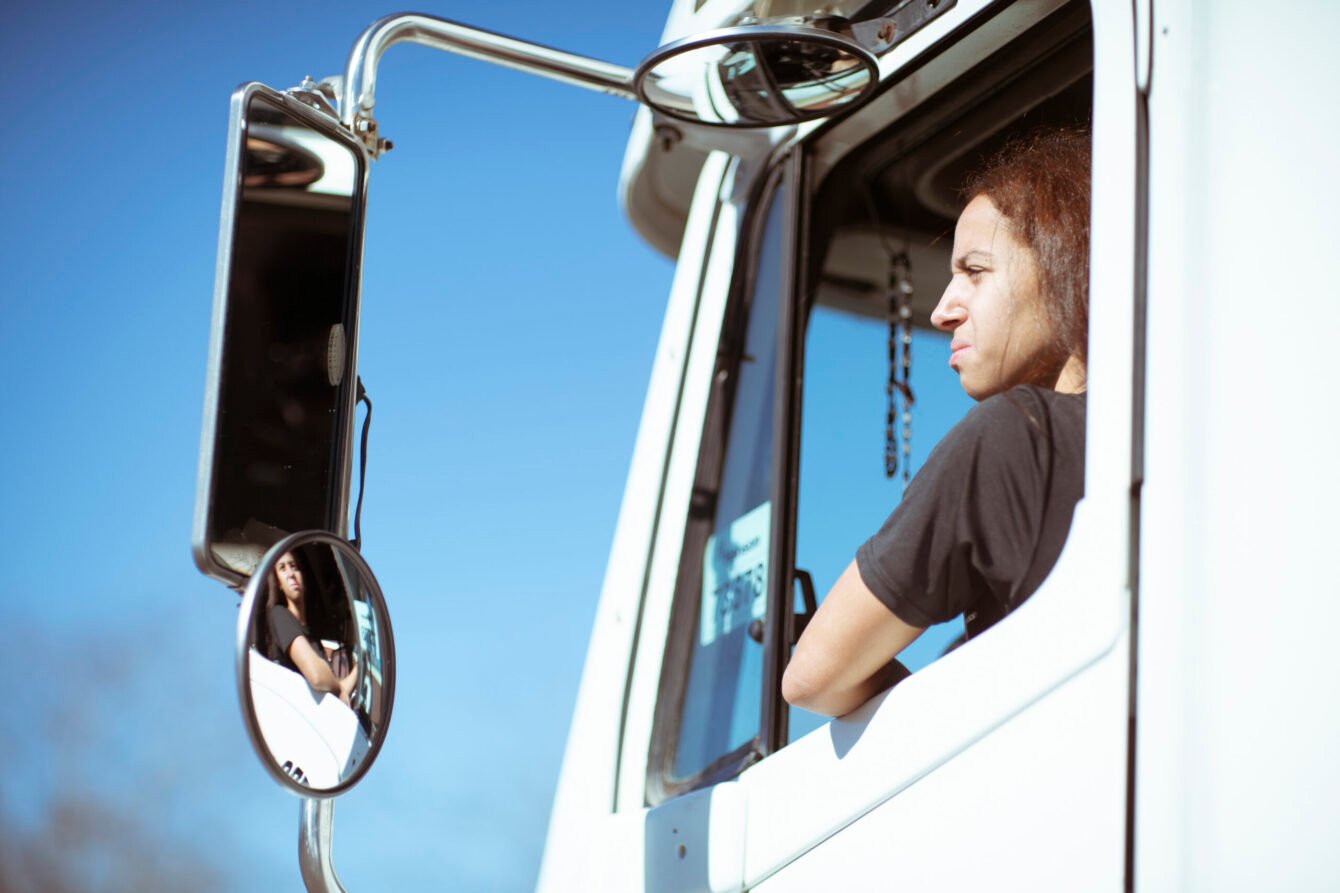
All photographs from Texas, December 2023, by Sandy Carson for Harper’s Magazine © The artist
“If you have to change friends, that’s what you gotta do,” our instructor, Johnny, told the twelve of us sitting in a makeshift classroom in a strip mall outside Austin. “They’re gonna be so jealous, because you’re gonna be bringing home so much money. Encourage them to get their CDL, too.”
A CDL is a commercial driver’s license, and if you pay attention, you’ll find variations on the phrase cdl drivers wanted everywhere: across interstate billboards, in small-town newspapers, on diner bulletin boards, on TV, and, most often, on the backs of semitrucks. Each of us had come to the Changing Lanes CDL School to answer that call.
Johnny’s rosy pep talk was built on the belief that trucking is still a lucrative career in America. And despite the devastating shortage of truckers observed by media outlets, politicians, and trucking associations, the classroom was full of people who seemed willing to buy in. The founder of Changing Lanes, a charismatic veteran named Delbert, asked for a show of hands: How many people definitely wanted to do long-haul trucking? Three hands. How many people were from Texas? Nearly all. Who had child support to pay? Four or five. How many people were here in a workforce training program? Five or six. How many people had been to prison before? At least four hands went up, fast.
Johnny and Delbert went over the school rules: no refunds, no talking back to your teachers, no name-calling, no drugs, no leaving trash inside the trucks. No phones, so give anyone who might need to contact you—“your children, your children’s school, your probation officer, your parole officer, your judge, your baby mama, your side chick, your wife, whoever”—your instructor’s number. And no being late: class starts at 7 am. But before we can get anywhere near a vehicle, we must pass a drug test and get our commercial learner’s permit. Doing so depends on how much we already know about trucks, or how well we can memorize the 178-page Texas Commercial Motor Vehicle Drivers Handbook in preparation for the written exam.
“If you show up at 7:01,” Delbert said, turning to me, “what’s gonna happen, Emily?”
“You’re going to be sent home,” I said.
We spent the day reading aloud from the handbook, starting with special requirements for Texas commercial motor vehicles. Each must carry flares, lanterns, or reflectors. Clearance lamps on the front of the truck should be amber, and mud flaps must extend to no more than eight inches from the surface of the road. Vehicles hauling cotton get special license plates. Special rules exist for farm tractors and “implements of husbandry.”
I once tried to read Greek before fully understanding its alphabet. That’s what it felt like to study the rules of operating a big rig before ever having popped the hood or climbed behind the wheel. The parts of an air brake system felt impossible to understand—in my notes, I kept writing “spring breaks” instead of “spring brakes.” Eventually, we reached a section titled driving safely, which included subheads: “signal your intentions,” “communicating your presence,” “importance of seeing hazards,” and “always have a plan.” It struck me as advice for more than just driving. Truckers should avoid emotional conversations when behind the wheel, the handbook told us. Daydreaming, too, should be avoided.
A few days later, after stumbling through practice tests at home, I headed to a Department of Public Safety office and submitted my application. I smiled for a picture and made my way to a cluster of computers, alongside anxious truckers in training from other schools, one of whom failed halfway through and walked right out. I came within one wrong answer of failing the air brakes section, but I passed the remaining questions and got my permit, an eight-and-a-half-by-eleven-inch sheet of paper that I would switch out with a laminated card that would soon arrive in the mail. A new pit materialized in my stomach on the way home: now I had to learn how to drive a truck.
The logistics industry has long sounded the alarm over the shortage of American truck drivers and the havoc it wreaks on supply chains, but just why that shortage exists gets less attention. Millions of Americans are trained to drive trucks and choose not to. Long-haulers, lauded as the backbone of our economy, live out of their trucks for weeks at a time, often working eighty-plus-hour weeks while earning little more than minimum wage. The economist Michael Belzer has equated commercial trucking to working in a “sweatshop on wheels.” The shortage is, in fact, a retention problem: annual turnover at large fleets in recent years has exceeded 90 percent. “It’s a self-inflicted wound,” Steve Viscelli, the sociologist, former trucker, and author of The Big Rig: Trucking and the Decline of the American Dream, told me, “because the jobs are so bad. We don’t really have a shortage of drivers. We just have a shortage of people willing to live that lifestyle.”
I wanted to know who, amid these conditions, was still feeding the churn. To do so, I needed to not only get close to truckers, but to understand what becoming one entailed, and trucking school would be the best place to do it. I called my friend Ramona, a trucker of two decades based in the Mojave Desert. I wanted her opinion on whether this was a bad idea. First, she lamented that I didn’t get my license before February 2022, when the federal government rolled out new rules for truck-driving education. Now anyone getting a CDL had to attend a registered school that followed a freshly standardized curriculum, which some industry veterans like Ramona feared might make the process lengthier. But she saw no downside to having a CDL. She added, when I asked her about being a woman in the industry, that she doesn’t get the clichéd assumption that women can’t drive huge vehicles. “We give birth,” she said. “We can drive trucks.” I don’t have children, so I found little comfort in this logic.
I was living in Austin and wanted to find a school I could commute to. The ones run by the big trucking companies, such as Knight and C.R. England, interested me—they reimburse students for their training on the condition that they work for the fleet after graduation. A Facebook post for Changing Lanes, which had just won one hundred thousand dollars in an entrepreneurship competition, caught my eye: “Contact us today to start the process towards living a dream life!” The school had also posted a music video starring a woman trucker rapping outside a big rig: “Making moves, changing lanes / Let’s clock a few miles in the right direction.”
Though their classes were in Pflugerville, an erstwhile sleepy farm town now booming with Californians and priced-out Austinites, the Changing Lanes truck pad—where we would actually learn how to drive—was in a suburb slightly further east, in Hutto. Tuition for the four weeks was $3,950. I enrolled in a course that would start in September and spent the whole summer trying not to think about it. Still, I’ve always liked school, and the more skills you can have in this economy, the better. Also, I like truck drivers.
Over four weeks, we would learn how to inspect, maneuver, and drive trucks, and would pass a litany of corresponding tests at the Department of Public Safety. Only after mastering inspections would we be allowed to learn the three truck maneuvers we’d be tested on at DPS, and then how to drive on the road. Once it was evident that we had learned these skills, Changing Lanes would schedule our final DPS exam for our CDLs.
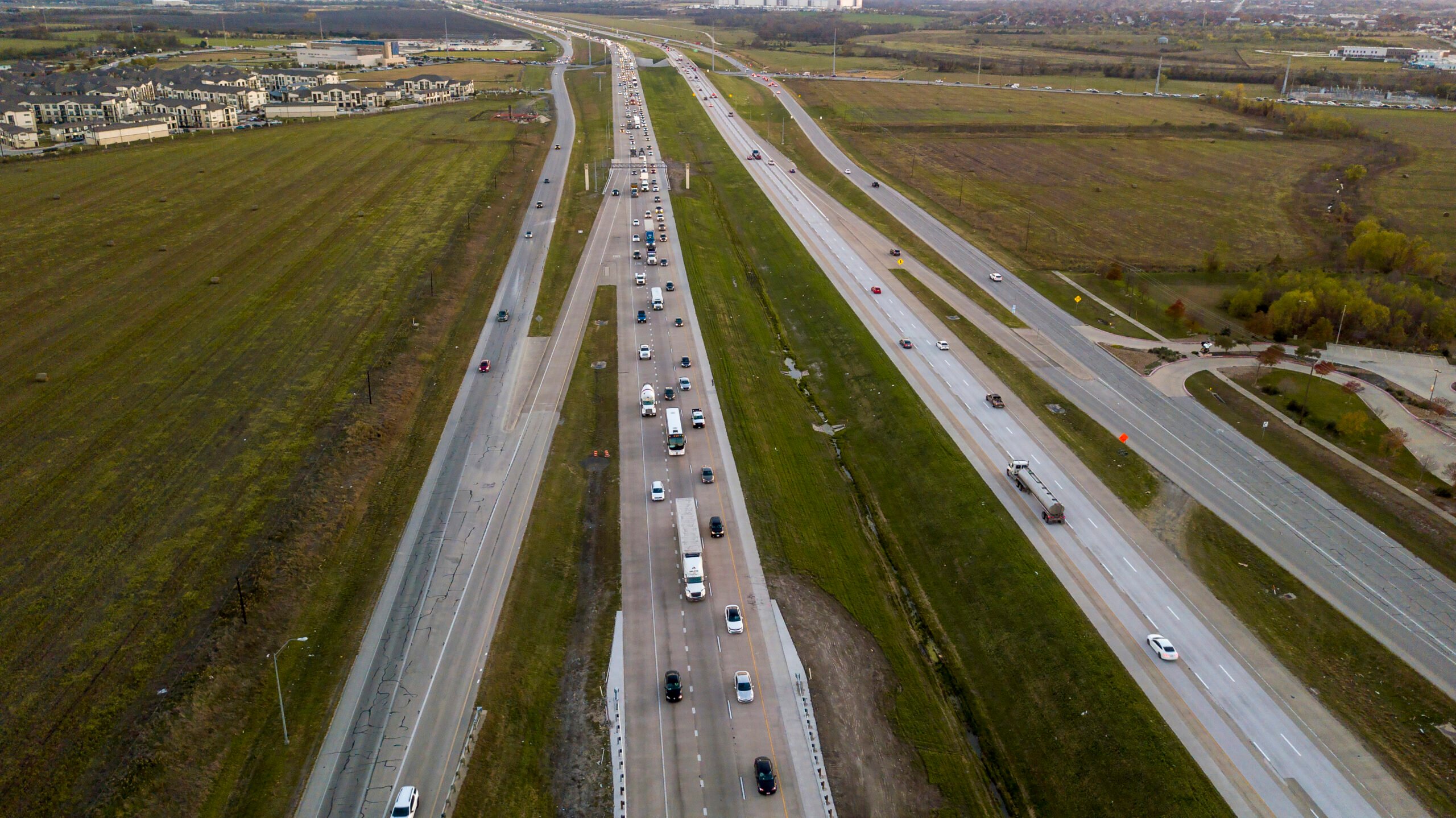
Texas State Highway 130
Whoever had passed the permit test was supposed to show up at the pad in Hutto on a Wednesday morning. I took the toll road through the last remaining parcels of farmland on the edge of Austin, all dotted with for-sale signs, toward the pad in Hutto. That stretch of highway, built to alleviate traffic on Interstate 35, has a speed limit of 85 miles per hour—the highest of any road in the Western Hemisphere.
The pad is across from a Dollar General. Students park at the top of a slope, where you can look out over the whole property, about the size of a Walmart parking lot. It used to be a concrete production facility, and it seems like whoever operated it left in a rush. Detritus and blocks of concrete lay about, carrizo cane and shrubs and weeds growing among them at random, and blue fabric seats torn out from a vehicle sat on the ground alongside broken camping chairs. Two white plastic tents had been set up to protect us from the heat, which in mid-September in central Texas was still oppressive. It felt like it was over one hundred degrees when we arrived, after the second hottest summer here on record. One of the tents sat beside a minibus that declared we prepare you for a career, not just your cdl. A few feet away was a box trailer with get your cdl in four weeks! on the side. I often considered why this message was turned in toward the lot and not out toward the street.
Five of us from the classroom showed up. Johnny blew his whistle, and we stood in a circle to introduce ourselves.
David, a clean-cut, soft-spoken blond in an American flag shirt, had been working in auto body shops the past twelve years; before that, he drove trucks in the Air Force, hauling ammo from Kuwait to Iraq in the dark of night. The real reason he enrolled in trucking school was because God had told him to.
Rey stood next to him, wearing a trucker hat stamped with stand firm, a message from 1 Corinthians. He had served in Afghanistan and Iraq before becoming a cop, but had recently started his own “hot-shotting” company, transporting smaller loads with a heavy-duty pickup truck and flatbed trailer. He needed to upgrade his license in order to operate new equipment.
Ashley, wearing the largest sun hat I’d ever seen, used to work in sales at AT&T, where she enjoyed giving people discounts on internet plans without her supervisor’s permission. She had a dream of owning an event planning company and saw trucking as a way to save money to get there.
Kendrick, in a taqiyah, was chummy with David and Rey, but he wouldn’t talk to me or Ashley, except to explain that he couldn’t speak to us on account of his religion.
And I was there to write about learning how to drive trucks. The rest of our classmates wouldn’t show up for a week or more, if at all.
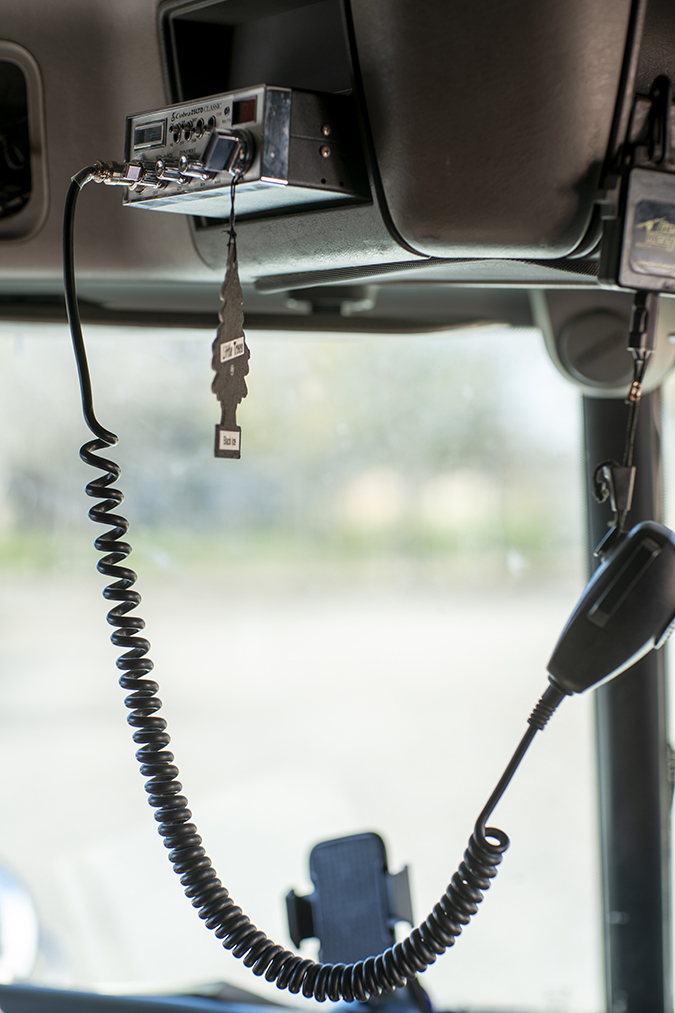
Left: A CB radio. Right: A mud flap
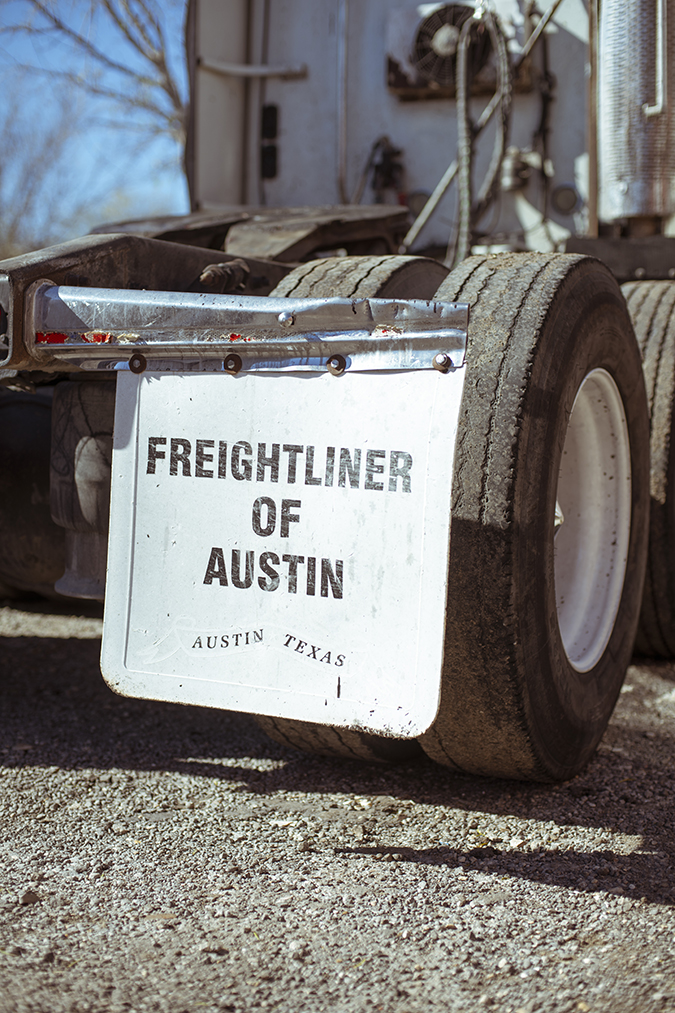
Johnny went over even more rules and then sent us to a tractor trailer at the back of the lot to go learn. The truck was a simple, sturdy single-axle painted white; when we got there, its hood was already open, its intestines on display. I held up a packet containing photos of the hundred or so truck parts we would need to memorize, trying to match the grainy black-and-white images to the jumble of wires, hoses, and metal in front of me. Rey, our de facto teacher, walked us through the engine compartment, steering, and suspension. We got to the coupling system, the hardware linking the tractor to its freight. The entire industry depends on this, the jaws of the fifth wheel clamping properly around the kingpin. We were crouching beneath the trailer now, relieved to be out of the sun.
We ran through the parts together over the following few days, eventually learning how to perform a pre-trip inspection, which truckers are supposed to do each time they set off on a job. We memorized the process exactly as the examiner at DPS expected to hear it—touching each part you inspect, identifying it correctly, and assessing its quality—in a semantic marathon that could take thirty minutes to run through straight. While practicing on the pad, we were liberal with our breaks, sitting on tires in the shade.
One morning our conversation turned toward Judgment Day, which Rey narrated for us. When Jesus returns, he said, everybody will be awakened, those in hell will be brought out, and the final judgment will sentence people for eternity. “Hell is just a temporary waiting place,” he explained.
Ashley chimed in. “Have you heard that people think earth is hell?” she asked.
Earth can feel like hell if you let the devil get to you, Rey told her. He told us the story of Job and then gestured at the godforsaken pad in front of us. “I feel like I’m being tested now.”
A young woman who looked about sixteen, wearing short-shorts and pink socks, walked over to us. Her name was Yanislevi, but she went by Yanis. She was in fact twenty-one and had been in CDL school for a grueling four months—three months longer than planned. She used to be an electrician, and before that a security guard. She wanted to give us a lay of the land. “I’m not talking shit,” she said, “but I am talking shit.” She told us that we shouldn’t expect much out of the school, and that we should attend classes on the weekends if we could; it was like a different country, with the instructors really putting in the work. And you were allowed to have your phone.
Later that day, during lunch, someone dropped off three pit-bull-mix puppies, and Yanis claimed one and carried it around like a baby. She named him Bonito. There was one more up for grabs, dark gray with blue eyes and a white spot on its chest, and it clung to me when I picked it up. Rey looked at us. “Pit bulls make good truck dogs,” he said.
Trucking is an industry steeped in some of the most stubborn of American aspirations: join the middle class; build a career you can count on; work without a boss looking over your shoulder. These are narratives whose centers do not hold, even in an industry that still takes place on the open road.
But they used to. After World War II, trucking became one of the highest-paying working-class jobs in America, backed by the Teamsters. Then, in 1980, in response to skyrocketing fuel rates, inflation, and nationwide strikes by drivers, Jimmy Carter deregulated the trucking industry, which meant that the government no longer had oversight of freight rates and routes. New low-cost carriers flooded the market, pushing union firms out of business. Prices for consumer goods stayed low, and drivers’ wages fell. The median annual pay for a trucker today is just shy of $50,000, which, according to Belzer, is less than half of what truckers were earning in 1980 when adjusting for inflation. Over the same span of time, union membership among truck drivers has fallen from around 60 percent to less than 10.
A classmate often wore a red T-shirt that said if diesel ain’t burnin’, then i ain’t earnin’. He saw the refrain as a motivator, but it also could be read as an admonition to the industry he was being trained to join. Drivers, particularly long-haulers, who make up about two million of the some 3.6 million truckers nationwide, are typically paid by the mile. Safety inspections, loading, unloading, fueling, and maintenance generally don’t count, nor does time spent waiting on loads. The Fair Labor Standards Act of 1938 exempts truck drivers from the right to overtime.
This landscape makes the American trucker both essential and disposable. As Viscelli writes in The Big Rig, “It is more profitable to manage the problem than to fix it.” But when a record eighty-one thousand trucking jobs went unfilled in 2021, contributing to the supply chain crisis, shipping costs rose and store shelves sat empty. Suddenly, the driver shortage was everyone’s problem. The Biden Administration unveiled a plan for getting more drivers on the road and keeping them there, which included pathways for veterans and young people, funding to help states issue CDLs faster, and a joint compensation initiative between the Departments of Labor and Transportation. A flurry of proposed legislation followed: bills guaranteeing drivers’ right to overtime, one seeking to retain veteran drivers and attract newcomers through tax credits, and another cutting the red tape around CDL certification. It remains to be seen what will become law, but what does seem clear is that the structural issues plaguing truckers are too consequential to ignore. The shortage improved last year, with sixty thousand vacancies, but the American Trucking Associations has warned that the figure could more than double by 2030.

Yanislevi
After a couple weeks, I got used to the odd rhythms of the days as a Changing Lanes student. Each morning, we’d practice inspections for the first two or three hours, and then we’d set up cones and get the trucks fired up for maneuver practice. There were, at most, two automatics on the pad at any time for as many as twenty people, so real practice behind the wheel was quite limited, as few of us knew how to operate the pad’s two manual trucks. Each minute had to count.
While we sat and waited for our turn, all there was to do was chew sunflower seeds and talk. We discussed love languages, supply-side economics, Putin, Pizzagate, parenthood, astrology, gardening, what happened in the desert (Iraq and Afghanistan), infidelity, prison, populism, OnlyFans, and, especially, what comes after trucking school. Most people had bought into the idea that becoming a trucker would change their life—that it was going to level them up, or at least be an on-ramp to something better than their current situation. “I’m tired of making chump change, man,” said a classmate: he’d been working in warehouses since leaving the army a few years ago. “I’m going for the big bucks.”
I took Yanis’s tip and spent Saturdays and Sundays on the pad too, where I finally got to practice maneuvers with KJ, an elegant instructor in his early forties. He had been a celebrated Texas rapper in the early Aughts, and he opened and closed each class with a sort of sermon. “There’s a sense of respect that you have to have in these trucks, period,” he told a crowd of us standing in a circle around him. KJ’s big message was to allow ourselves grace and mercy while learning how to drive big rigs. “If this was easy,” he reminded us often, “everyone would be doing it.”
The first maneuver I learned on the pad was straight line backing, which is exactly what it sounds like: reversing the truck in a straight line between two rows of cones sometimes set just ten feet apart. The first few tries, I felt like the captain of a ship who woke up at sea without remembering how she got there, or like I was trying to walk on a leg that had fallen asleep. When reversing a combination vehicle, everything is opposite from a normal passenger vehicle—turn the wheel left and the trailer goes right. I hadn’t been aware of the intensity of my pedal anxiety until I got behind the wheel of a big rig. The first time I pressed the accelerator, I thought I might pass out.
KJ then told me it was time to learn offset backing, where you reverse the rig from one row of cones to another. “She’s gonna offset this motherfucker!” he shouted as he jumped in the passenger. This was doing geometry with a death machine. A tightness spread across my chest and throat. I was overwhelmed and embarrassed to be overwhelmed, and I ended up freezing, unable to maneuver the trailer even remotely into an angle that would thread it between the cones. I felt everyone’s eyes on me as I failed wildly.
I got out of the truck and went for a walk. People offered advice. David told me to pretend that the truck seat was an armchair at home; Yanis said I should rent a moving truck and take it to an empty parking lot; another instructor suggested I buy a toy truck to practice with. I thought he was messing with me, but he was serious, and I ended up ordering a white Kenworth model in the mail and setting up a mock pad with blue masking tape at home on the floor.
To explain my nervousness, I told a few guys about the time in high school when I accidentally drove my mother’s car into our house, pressing on the gas instead of the brakes while trying to ease into the garage and putting a giant crack in the living room wall.
“Oh, that’s your name, that’s your CB handle!” one of them shouted, referring to nicknames truckers use on citizens band radio, a service for short-range communication. “Thru-the-Wall!”
Immediately, Rey came up with an alternative: House Hunter.

Development near Pflugerville
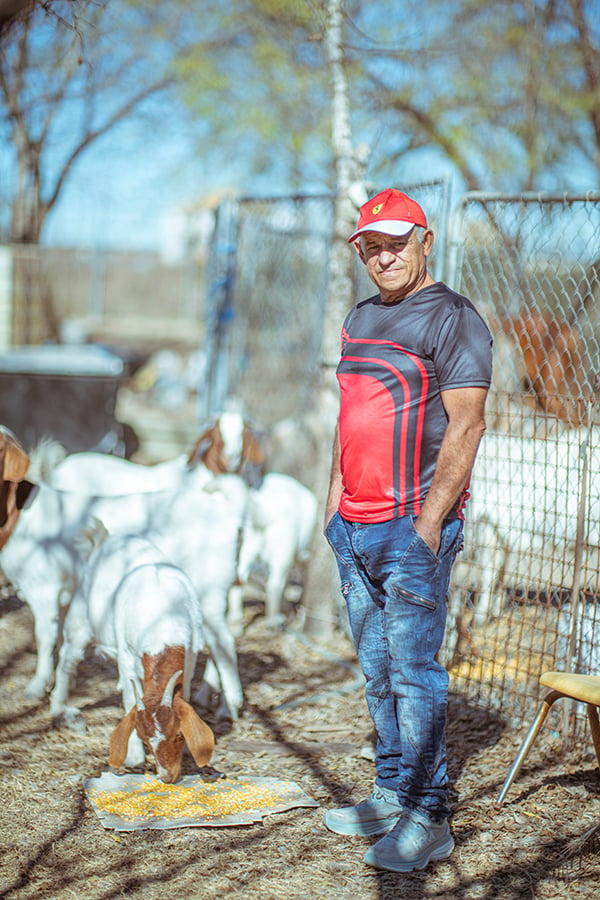
Yanis’s father on his property
The Changing Lanes pad was about 15 percent women, representing a shift in the industry, historically male. The women generally fell into two categories: early thirties or younger and childless, like me, or former teen moms entering a new phase of their lives.
Dolly Jen was in the latter group. She’d driven school buses for seventeen years and had driven at Tesla, picking up employees and taking them around the property. Trucking school was the first thing she was truly doing for herself. Dolly is resourceful; after class one Sunday, I saw her take a half-eaten banana and rub it on the license plates of her Oldsmobile—she swore she hadn’t received a toll bill in a month.
Brandy, nearly forty, moved to Austin from Chicago in 2019, after one of her sons was shot and killed on his way home from high school. She wanted to make enough money driving trucks to launch a foundation in his name that would provide direct services to communities like the one where she grew up. For now she needed to get out of Changing Lanes—she’d been there since July.
Cayenne, thirty-two, drove a burgundy Harley-Davidson and had a temper. “Cayenne is a hot pepper, literally,” KJ said. (Later, she would get suspended for a month for having an attitude.) She was the vice president of an all-women motorcycle club and wanted to long-haul while she was single and childless. “Keep ten toes on the ground and your head on a swivel,” she told me.
Yanis was younger than the rest of us, but she was already stressed about her future. She wanted to be out of her parents’ place by winter, but that meant she needed to graduate from Changing Lanes and start filling her nearly empty bank account. Her family lived on ten acres of land in an unincorporated pocket of Travis County that was still mostly rural but was being eaten up fast by developers. Yanis reckoned that her father—who was also a truck driver—could sell the land for a couple million, but he didn’t want to. The problem was that they didn’t have utilities, which was why she wanted to make enough money to move out before the cold set in. It was weird being surrounded by a boomtown but disconnected from it, she told me: “We kind of live like in the old times.”
Yanis had worked as a cleaner at an airport lounge; at a UPS warehouse; as a security guard at an Apple corporate office in the hill country. Then she started working security at Tesla’s nearby Gigafactory. It took a full hour to walk across; when Elon Musk came to visit, his dog apparently had its own security guard. Yanis and her boyfriend, who also worked there, figured out that electricians made the best money at the factory, so they became electricians. In all of her work, she’d often been one of the few women. “You have to show them that you can do things better than them,” she said. “If you’re doing an outlet, the outlet has to look beautiful.” Ultimately, though, Yanis’s jobs have taught her about how the world works—that “the job that you can die on,” she told me, “is where they’re gonna pay you the most.”
Her boyfriend had recently become a trucker and convinced her to join him. Now he wanted to do the long haul, which can be a tough decision for women truck drivers—sleeping in your rig at truck stops alone at night, or sharing a truck 24/7 with a co-driver you don’t know. Yanis would long-haul if she could drive with her boyfriend. Or maybe she’d become a real estate agent. Or something else entirely.
To long-haul or not to long-haul was a frequent topic of conversation on the pad, largely due to the money and the allure of the open road. But even long-haul trucking is not what it used to be. Since the Thirties there have been rules about the number of hours truckers can drive at a time, but how those hours are tracked has transformed over the past decade. Drivers used to keep their own records by hand, and it was common to doctor logs.
Then, in 2017, a federal mandate turned logs digital. Now every long-haul driver must have a logging device, which is usually hardwired to their truck’s engine. But, as Karen Levy documents in Data Driven: Truckers, Technology, and the New Workplace Surveillance, digital logs treat a symptom, not the cause: drivers are exhausted because of a warped pay structure, and there is no evidence that the mandate has made roads any safer in the first place. It has also opened the doors to deep managerial surveillance, like cameras that face not only out toward the road but in toward the driver, monitoring their eye movements, and baseball caps that monitor their brain waves.
Unsurprisingly, most truckers hate being monitored. Prohibiting inward-facing cameras is among the demands that the Teamsters fight for in new contracts. To live out of a machine and risk your life running 80,000 pounds on interstate America, you have to believe in what you do. Surveillance and a broken pay structure wear that belief thin.
Plans of buying a truck and becoming an owner-operator came up just as often. Many of my classmates dreamed of this: long-hauling in their own truck and running the business behind it, an escape from the trappings of traditional freight hierarchies. There are some 350,000 owner-operators in the United States. One of my classmates, a twenty-six-year-old who worked as a glass setter, told me that if he doesn’t buy his own truck by the age of thirty, he doesn’t know what he’s going to do with himself. He planned to long-haul hazmat on his own, so he could “see the states and see all the pretty shit on my own time,” he told me. “If I don’t want to take a load, I’ll go look at a mountain or something.”
But hopes of making it big on your own seldom square with reality. Owner-operators bear a disproportionate share of the risks and costs: fuel, maintenance, and insurance all fall on the driver, and lease agreements are often predatory. The industry, meanwhile, has popularized a model whereby drivers lease to own trucks from the same carriers they’ve contracted their services to. In reality, these so-called owners are employees, shoring up the capital required to haul freight so that the carrier doesn’t have to.
While the freight boom of the pandemic led many truckers to go independent to fill the gaps, by 2022 observers were announcing a “trucking bloodbath” due to soaring fuel prices and plummeting freight rates, and the effects have continued. Owner-operators felt the pressure, and many of them still do. According to a survey by the supply chain market news service FreightWaves, more than a third of owner-operators claimed that they would leave the industry “if the market does not rebound materially by the end of 2023.”
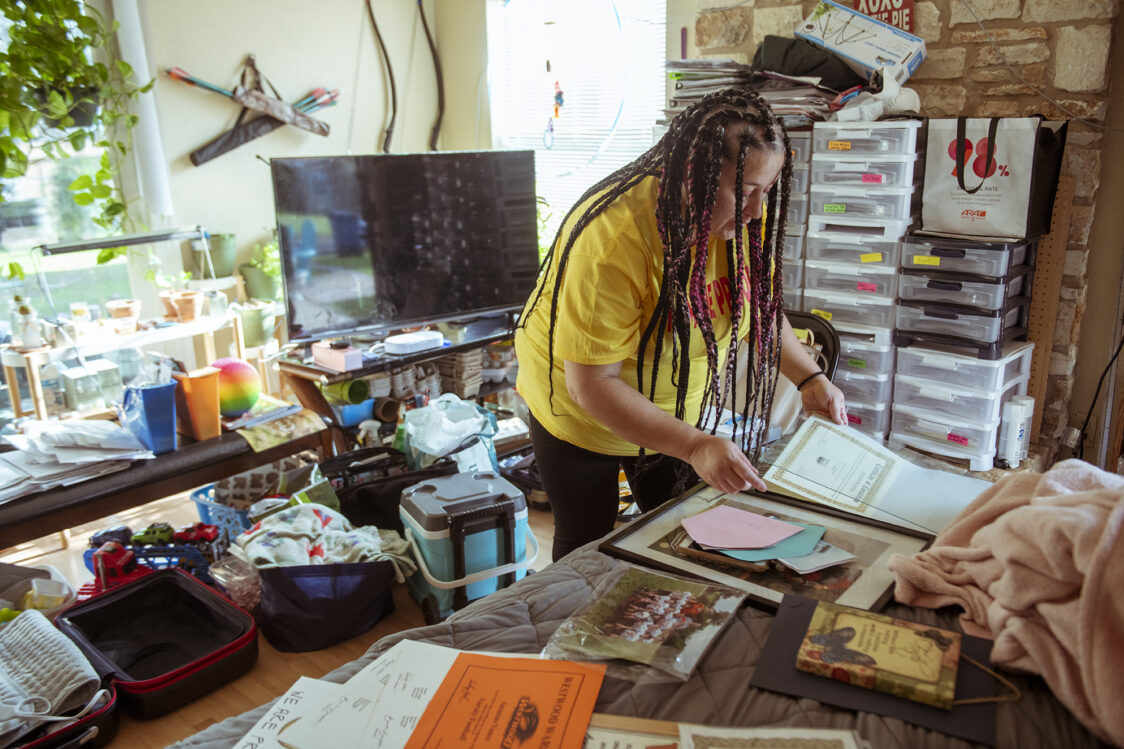
Dolly Jen at home
I looked up at the get your cdl in four weeks sign one morning. It would have been the final day of class if this were effectively a four-week course, but a number of the people out here were going on week seven or more, and it seemed like everyone was in a pissy mood. A classmate from Turkmenistan told me that the weekday class was the closest he’d felt to being in a dictatorship since he left. “They’re holding us hostage,” David said while he sat on a tire, a cloud offering rare relief from the merciless sun.
As the weeks went on, the purgatory of Changing Lanes got worse. Tests got rescheduled because of mechanical problems. Sunflower seeds were banned. Rey and David had graduated, but I was still on the pad, going mostly on weekends. The situation intensified when one of the trucks disappeared inexplicably, and the pad was down to one automatic for several weeks. “We just gotta get out of here,” a classmate said on their twelfth week.
When class got canceled one morning, I called up Delbert, the owner. He reminded me that I was being prepared for a career. As a trucker, he explained, there are times when you’re going to drive hours to pick up a load only to find that it’s not there, and then you’re going to have to turn around and go home. It occurred to me that the school was, in fact, delivering on its promise.
Eventually, I was scheduled for my pre-trip and in-cab inspection tests, the first third of the exams I neededto pass in order to get my CDL. I went to DPS one morning in Georgetown, a suburb twenty minutes from the pad, and the examiner met me out by the truck and held out four little laminated cards, face down, to determine which part of the truck I’d be tested on. I picked one from the center and turned it over: D. A was the engine compartment, steering, and the front axle; B was mid truck, fuel, and the rear axles; C was the trailer; D was all of the above. “You would choose D,” he said.
I went through the inspection, front to back, touching and naming each part, including the fifth wheel, which was coated in thick black grease that covered my palms. I got through the pre-trip inspection only missing one small element—the rearmost mud flap—and moved on to in-cab. The first set of brake tests went well, I thought. But after I finished the second set, the examiner informed me that I’d failed. After building enough air pressure for the first set of brake tests, I hadn’t turned off the truck like I was supposed to. I got out of the truck, went to my car, and cried, tears mixing with grease. I couldn’t remember the last time I’d felt so incompetent.
Two weeks later, I returned to DPS and passed my second go at the pre-trip inspection, and I then passed a maneuvers test—straight back, offset, and parallel—a week later without hitting any cones. The road test wasn’t an option that day because the vehicle registration on the Changing Lanes truck had expired. This came as somewhat of a relief—I hadn’t had more than thirty minutes on the road with an instructor, and I didn’t feel ready. I didn’t want to kill anyone.
In the DPS lobby that afternoon, I met Cory, a stylish trucker with a warm smile. He was an instructor at a nearby CDL school that’s really more of a one-on-one tutoring service. In an act of desperation, I enlisted him to give me a driving lesson that evening—I’d been in trucking school for almost two and a half months, and this seemed like my way out. I met him and his test truck, a white single-axle hooked up to a robin’s-egg-blue flatbed trailer decorated with student driver stickers. The rig felt jumpy at first, but Cory had a calming presence, and I was getting a feel for how to turn. We took the same route the local DPS would use on the exam. It featured a tight hairpin bend on a quiet street, followed by a mock emergency stop where we reviewed where to place the reflective triangles. Finally, I drove toward the sunset, merged onto I-35, and found myself easing into the road. I still didn’t feel qualified to have an examiner in the passenger seat, but considering the unpredictability of time slots and equipment, it was now or never.
At 7:30 the next morning, I went to DPS and waited in line. I could feel the weight of my favorite pebble in my pocket—I’m a sucker for ad hoc talismans. A slight, patrician middle-aged woman with cropped dark hair met me near the truck in a yellow vest, and we got in. I turned on the truck and let air pressure build, revving it a little. We began.
I felt like I was watching myself drive from above. We approached the tight right turn, and I was shocked to pull it off. When the time came to merge onto I-35, which was busy during rush hour, I missed calling out a bridge height because I was too focused on my mirrors; after that, I overdid it by calling out all the mile markers. After about thirty-five minutes, she told me to turn off the highway. It all seemed too short. I was sure I did something wrong and that she was about to tell me I’d failed. I parked and turned off the truck.
“You did fairly well,” she said. I wasn’t turning properly, and with practice I’d get smoother on my brakes. “Other than that, you did great. You did pass.”
I remembered one story from the pad about a student climbing on top of the truck after he passed his road test, and in that moment, I understood the impulse. The examiner cut the corner off my regular driver’s license—henceforth void—and handed me a piece of paper with my photo on it: my temporary Class-A CDL. The permanent one would arrive in a couple of weeks. I got in my car and screamed.
I was back in Austin months after I graduated when Yanis invited me out to her family’s property in Del Valle. She greeted me at the gate in a gray T-shirt that read i survived changing lanes cdl school, which she’d receive at a multi-class graduation party. She paired it with purple running shorts and steel-toed cowgirl boots. A big dog trailed behind her—not Bonito, who had disappeared a few months earlier, but a German Shepherd mix named Rocky. Two horses galloped around her parents’ double-wide trailer. I’d been nostalgic for the country in central Texas, the sound of the breeze through the oaks and the quality of light. But the road to the ranch was busy with trucks hauling heavy equipment and pipes for the massive development two lots over. “It’s about not to be the country,” Yanis said.
Yanis was working for a food distribution company driving doubles—two twenty-eight-foot refrigerated box trailers—up and down I-35 between Austin and San Antonio. She starts her shift at a truck yard near the airport at 5:30 pm and is usually done by 2 am. The situation is relatively good for an entry-level trucker: she earns pay per trip, and if she has to wait for more than an hour for a load, her company pays her for the time. She gets to sleep in her own bed every night. But her boyfriend was still trying to talk her into a long-hauling job since he became an over-the-road trucker for a company based out of Arkansas.
David, meanwhile, did become a long-hauler, in his own way. He bought a silver Ford F-550 and a forty-foot flatbed and worked for Rey before starting his own one-truck company, which he named Neverland. Dolly stayed regional—she got certified in manual, doubles, triples, and hazmat, and worked fifteen-hour days delivering construction materials on a flatbed to east Texas. But she left that job after five months because she found the company’s safety practices subpar; as soon as her youngest child graduates from high school this summer, she wants to go over-the-road. Ashley is long-hauling for a big carrier based in Tulsa, and Cayenne for one in Wisconsin. Brandy works the night shift locally, hauling concrete. Changing Lanes now provides in-house testing; it also raised its tuition to $4,150.
Yanis’s boyfriend had parked his rig beside a small herd of goats. It was his last day off before eight straight weeks on the road. While he was out running errands, Yanis and I sat in the cab—she in the driver’s seat and I shotgun. An emu stood beside my open door. The space was cramped, stuffed with bunk beds, a fridge, a microwave, a hot plate, a rice cooker, and cleaning supplies. No matter how much she cleaned, the upholstery still smelled from the trucker who had chain-smoked in there before her.
I knew Yanis well enough to tell that the question of the long haul was weighing on her. She wanted to move off the ranch and get an apartment, but her boyfriend wanted to make this smoke-stained cab home instead; long-hauling for a big carrier helps for insurance when you buy your own truck. But that meant the pay wouldn’t be much better than her local driving job, and the hours would be much worse. And the road can be a tough place. She told me that in a single week her boyfriend had blown out a tire, struggled to open his fuel tank cap, and seen a dead body at a truck stop.
“I don’t know,” Yanis said with a touch of despair. “I don’t want to think about it right now.” So we climbed out of the truck. We went to feed the horses.


